 The following are frequently asked questions about the REAL ID program that would be useful to the public.
The following are frequently asked questions about the REAL ID program that would be useful to the public.
Q: What is REAL ID?
Passed by Congress in 2005, the REAL ID Act enacted the 9/11 Commission's recommendation that the Federal Government “set standards for the issuance of sources of identification, such as driver's licenses.” The Act established minimum security standards for state-issued driver's licenses and identification cards and prohibits Federal agencies from accepting for official purposes licenses and identification cards from states that do not meet these standards. These purposes are:
- Accessing Federal facilities
- Boarding federally regulated commercial aircraft
- Entering nuclear power plants
Q: When will REAL ID be enforced?
The final enforcement deadline is October 1, 2020. By this date, not only must all states be issuing Real ID-compliant licenses or IDs, but individuals must also have visited their state’s driver’s licensing agency and obtained a REAL ID compliant card, or acceptable alternative such as a U.S. passport, if they wish to fly on commercial aircrafts or access federal facilities.
Q: What happens on October 1, 2020?
Federal agencies, including DHS and TSA, may only accept state-issued driver’s licenses and identification cards as identification for purposes of accessing federal facilities - including TSA airport security checkpoints - if the license or card was issued by a REAL ID compliant state in accordance with the REAL ID security standards (meaning the license or card must include the REAL ID compliant star marking). Enhanced Driver’s Licenses (EDL) issued by Washington, Michigan, Minnesota, New York, and Vermont are considered acceptable alternatives to REAL ID-compliant cards and will also be accepted for official REAL ID purposes. Most EDLs do not contain the star marking and this is acceptable.
Q: Are all states issuing REAL ID compliant cards?
DHS is working closely with all states and territories to provide assistance and guidance to achieve full compliance by the October 1, 2020 deadline. As of September 5, 2019, 50 states and territories are fully compliant with the REAL ID requirements, and all states are on track to begin issuing compliant licenses and IDs by the October 1, 2020 deadline.
Q: How do I get a REAL ID?
Visit your state’s driver’s licensing agency website to find out exactly what documentation is required to obtain a REAL ID. At a minimum, you must provide documentation showing: 1) Full Legal Name; 2) Date of Birth; 3) Social Security Number; 4) Two Proofs of Address of Principal Residence; and 5) Lawful Status.
States may impose additional requirements, so check with your state’s driver’s licensing agency website, before visiting them in person, for additional guidance and assistance.
Q: How do I know if my license or identification card is REAL ID compliant?
REAL ID-compliant cards will have of one of the following markings on the upper top portion of the card. If the card does not have one of these markings, it is not REAL ID-compliant and won’t be accepted as proof of identity in order to board commercial aircraft.

Examples of REAL IDs:
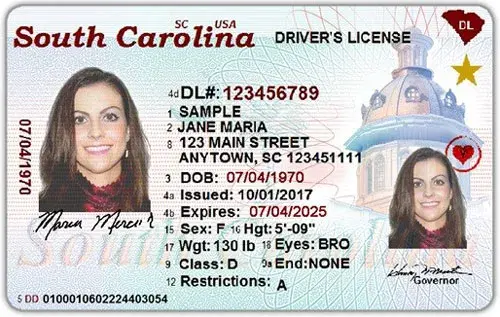
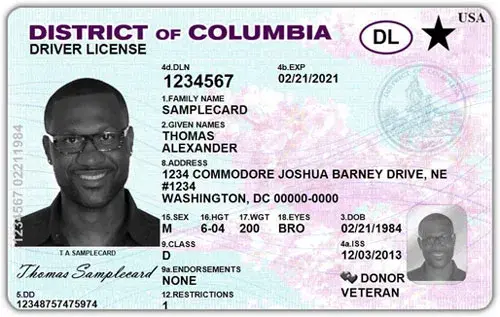
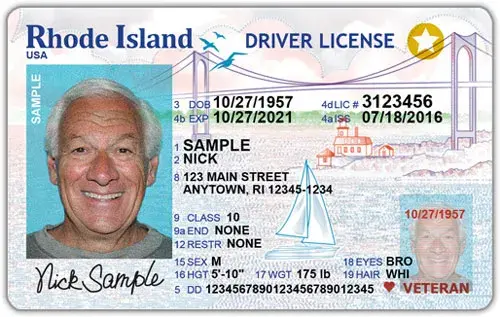
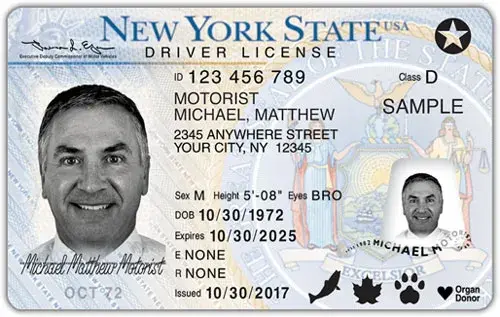
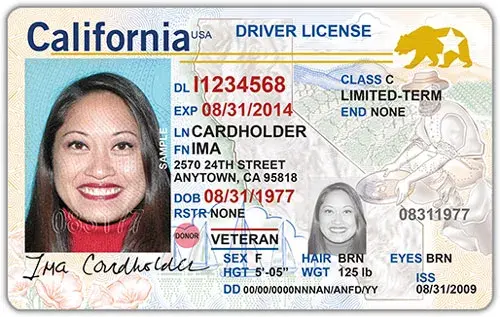
Q: When will I need to change how I travel domestically?
Beginning October 1, 2020, every state and territory resident will need to present a REAL ID compliant license/ID, or another acceptable form of identification, for accessing Federal facilities, entering nuclear power plants, and boarding commercial aircraft. The card, itself, must be REAL ID compliant unless the resident is using an alternative acceptable document such as a passport or passport card, or state-issued Enhanced Driver’s License. The Act does not require individuals to present identification where it is not currently required to access a Federal facility (such as to enter the public areas of the Smithsonian) nor does it prohibit an agency from accepting other forms of identity documents (such as a U.S. passport or passport card).
Q: Will minors need to have driver's licenses/ identification cards to fly domestically?
No. TSA does not require children under 18 to provide identification when traveling with a companion within the United States. The companion will need acceptable identification.
Q: What happens to travelers who show up without a compliant license? Will TSA turn them away?
Travelers who do not present a REAL ID-compliant license or acceptable alternative beginning October 1, 2020 will not be permitted through the security checkpoint.
Q: Is a passport my only other option?
No. TSA accepts several other forms of identity documents. For more information on acceptable forms of identification for boarding aircraft, please visit TSA’s website at https://www.tsa.gov/travel/security-screening/identification.
Starting October 1, 2020, every state and territory resident will need to present a REAL ID compliant license/ID, or another acceptable form of identification, for accessing Federal facilities, entering nuclear power plants, and boarding commercial aircraft. The card, itself, must be REAL ID compliant unless the resident is using an alternative acceptable document such as a passport. The Act does not require individuals to present identification where it is not currently required to access a Federal facility (such as to enter the public areas of the Smithsonian) nor does it prohibit an agency from accepting other forms of identity documents (such as a U.S. passport or passport card).
Q: Can I use my REAL ID card to cross the border into Canada and Mexico and for international travel?
No. REAL ID cards cannot be used for border crossings into Canada, Mexico or other international travel.
Q: Can I use my REAL ID for sea (cruise) travel?
No. REAL ID cards cannot be used for international sea cruise travel.
Q: Do I need a passport if I have a REAL ID?
If you are traveling internationally you will still need your passport. If you are traveling domestically, you will only need one valid form of identification – either your REAL ID or another acceptable alternative such as a passport, not both.
Q: What type of state-issued driver’s licenses and identification cards does the Department of Homeland Security currently accept as identification to access its buildings and facilities and at TSA airport security checkpoints?
Until full enforcement of REAL ID begins on October 1, 2020, DHS and its component agencies, including TSA at its airport security checkpoints, will continue to accept for identification purposes all state-issued driver’s licenses and identification cards issued by compliant states, as well as noncompliant states with a valid extension.
Q: Will a federal agency accept my Enhanced Driver's License?
Yes. State-issued Enhanced Driver's Licenses (EDLs) are designated as acceptable border-crossing documents by DHS under the Western Hemisphere Travel Initiative and are acceptable alternatives for official federal purposes such as accessing a Federal facility or boarding a commercial aircraft. Individual agency policies may still apply.
Michigan, Minnesota, New York, Vermont, and Washington are the only states that currently issue EDLs. For more information on EDLs, please go to https://www.dhs.gov/enhanced-drivers-licenses-what-are-they.
Q. What about non-DHS federal entities? What types of licenses and identification cards will they accept for access purposes?
Federal agencies have the authority to set their own minimum security access requirements and, if desired, decide not to accept noncompliant marked cards before the October 1, 2020 deadline.
For example, The U.S. Department of Defense (DoD) recently finalized an update to its DoD-wide installation security policy and is in the process of no longer accepting noncompliant marked cards across all of its facilities and installations. However, DoD will continue to accept state-issued noncompliant unmarked "legacy" cards until the October 1, 2020 deadline.
To ensure you have the proper identification, DHS recommends that you contact the federal agency you plan to visit in advance, to obtain information regarding identification requirements.
As a reminder, the REAL ID Act applies when an individual presents a state-issued driver’s license or identification card to a federal agency for an “official purpose” as defined in the Act and regulations, such as boarding a federally regulated commercial aircraft. Although a REAL ID card may not be necessary for other purposes such as driving, voting, banking, or applying for benefits or employment, we recommend checking with the relevant state, local, or commercial entities regarding their specific identification requirements.
Q: Is DHS trying to build a national database with all of our information?
No. REAL ID is a national set of standards, not a national identification card. REAL ID does not create a federal database of driver license information. Each jurisdiction continues to issue its own unique license, maintains its own records, and controls who gets access to those records and under what circumstances. The purpose of REAL ID is to make our identity documents more consistent and secure.
Q: How does REAL ID implementation impact states that provide driver's licenses and IDs to certain non-citizens/undocumented immigrants?
REAL ID allows compliant states to issue driver's licenses and identification cards where the identity of the applicant cannot be assured or for whom lawful presence is not determined. In fact, some states currently issue noncompliant cards to undocumented individuals. Noncompliant cards must clearly state on their face (and in the machine readable zone) that they are not acceptable for REAL ID purposes and must use a unique design or color to differentiate them from compliant cards. DHS cautions against assuming that possession of a noncompliant card indicates the holder is an undocumented individual, given that individuals may obtain noncompliant cards for many reasons unrelated to lawful presence. Possession of a noncompliant card does not indicate that the holder is an undocumented individual, given that individuals may obtain noncompliant cards for many reasons unrelated to lawful presence.
Q: How will the phase-out of the Deferred Action for Childhood Arrivals (DACA) Program affect state issuance of driver's licenses and IDs to DACA beneficiaries?
The REAL ID Act allows states to issue temporary (i.e., limited-term), REAL ID-compliant driver's licenses and ID cards to applicants who provide valid, documentary evidence that they have “approved deferred action status.” [Sec. 202(c)(2)(B)(viii)] Under the REAL ID regulation, applicants with approved deferred action who hold valid Employment Authorization Documents (EADs) and Social Security Numbers (SSNs) may qualify to receive temporary REAL ID driver's licenses and ID cards. The Deferred Action for Childhood Arrival (DACA) Program standardized and expedited the process for obtaining these supporting identification documents for individuals with Deferred Action seeking REAL IDs. Individuals with approved Deferred Action, valid EADs and valid SSNs may continue to hold temporary (limited-term) REAL IDs until their expiration. In any case, REAL ID compliant states may continue to issue noncompliant licenses and IDs to individuals with or without lawful status, including deferred action, as defined under the REAL ID Act.
Q. Can a person who was granted Temporary Protected Status (TPS) get a REAL ID-compliant license/ID? How long will it be valid?
Yes, a TPS beneficiary can obtain a REAL ID compliant license or identification card. The Secretary of Homeland Security may designate a foreign country for TPS due to conditions in the country that temporarily prevent the country's nationals from returning safely, or in certain circumstances, where the country is unable to handle the return of its nationals adequately. USCIS may grant TPS to eligible nationals of certain designated countries (or parts of countries), who are already in the United States. Eligible individuals without nationality who last habitually resided in the designated country may also be granted TPS.
The validity period of the license or ID card generally depends upon the length of the TPS period. When DHS designates or extends TPS status for a country, it can do so for 6 months or longer through a Federal Register Notice. A TPS beneficiary’s status is tied to a country designated for TPS. Pursuant to Section 202(c)(2)(C)(ii) of the Real ID Act of 2005, a temporary driver's license or temporary identification card issued to individuals who have a pending or approved application for TPS “shall be valid only during the period of time of the applicant's authorized stay in the United States or, if there is no definite end to the period of authorized stay, a period of one year.”
For purposes of assessing compliance with the REAL ID Act, please note that there is no definite end to the period of authorized stay for TPS beneficiaries who present a Form I-766, Employment Authorization Document (EAD) that contains a Category Code of A-12 or C-19 and a “Card Expires” date from the list below.
- 07/05/2016
- 07/22/2017
- 11/02/2017
- 01/05/2018
- 01/22/2018
- 03/09/2018
- 06/24/2018
- 07/05/2018
- 11/02/2018
- 01/05/2019
- 04/02/2019
- 06/24/2019
- 07/22/2019
- 09/09/2019
- 01/02/2020
- 01/05/2020
- 03/24/2020
An EAD that meets the above description is valid documentary evidence of TPS required by the Real ID Act of 2005, Section 202(c)(2)(B)(vii) and is acceptable for REAL ID purposes. Although a response from the Systematic Alien Verification for Entitlements (SAVE) program confirming immigration status provides a designation end date for TPS, these individuals do not have a definite end to the period of authorized stay. Pursuant to Section 202(c)(2)(C)(ii) of the Real ID Act of 2005, a temporary driver's license or temporary identification card issued to individuals who have a pending or approved application for TPS “shall be valid only during the period of time of the applicant's authorized stay in the United States or, if there is no definite end to the period of authorized stay, a period of one year.”
Issuance of REAL ID Compliant Documents to Citizens of the Freely Associated States
On December 17, 2018, President Trump signed the REAL ID Act Modification for Freely Associated States Act, Public Law 115-323. This Act amends the REAL ID Act of 2005 to authorize states to issue full-term REAL ID compliant driver’s licenses and identification cards to citizens of the Federated States of Micronesia, the Republic of Palau, and the Republic of the Marshall Islands (collectively known as the Freely Associated States, or FAS) who have been admitted to the United States as nonimmigrants pursuant to a Compact of Free Association and who meet the identification requirements of the REAL ID Act.
Q: What does the legislation do? Citizens of these countries are nonimmigrants and have only been issued temporary/limited term licenses in the past.
The REAL ID Act Modification for Freely Associated States Act amends the REAL ID Act to separate citizens of the Freely Associated States from the categories of non-U.S. citizens who are only eligible to receive a temporary (limited term) REAL ID- compliant driver’s license or identification card with a validity period no longer than the period of authorized stay in the United States, or if there is no definite end to the period of authorized stay, one year. With this amendment, citizens of the Freely Associated States who present acceptable evidence of identity and lawful status under the REAL ID Act and its implementing regulations should now receive a full-term driver’s license or identification card, rather than a temporary one.
Q: What identity and lawful status documents will FAS citizens need to present in order to obtain a REAL ID compliant license?
DHS recently designated an unexpired foreign passport with an approved I-94, with a valid visa no longer required, documenting the applicant’s most recent admission to the United States under a Compact, as acceptable documents FAS citizens may present to establish identity in order to obtain a REAL ID license or identification card. FAS citizens also may present one of the other identity documents listed in the regulations, including an unexpired passport, with a valid, unexpired visa (if applicable), and approved I-94, an unexpired employment authorization document, or a previously issued REAL ID compliant driver’s license or identification card (in which case, a valid passport and I-94 is acceptable evidence of lawful status). In all cases, the documentation presented for proof of identity and lawful status must be verified through Systematic Alien Verification for Entitlements (SAVE).
Q: What if an applicant states he or she has been in the United States for a number of years and does not have a valid passport?
Freely Associated States citizens who entered the United States lawfully years ago may have passports that have expired. In order to be issued a REAL ID-compliant document, they will need to renew their passport or present another acceptable identity document, such as an unexpired EAD.
Q: What will the validity period be for REAL ID-compliant driver’s license or identification cards issued to citizens of the Freely Associated States who present the necessary identity and lawful status documents? Will these documents look any different from documents issued to a U.S. citizen?
The appropriate validity period of the driver’s license or identification card will be consistent with the state’s regular expiration period for full-term REAL ID-compliant documents and carry the same compliant markings without any additional language.
Q: Will other classes of nonimmigrants be eligible to present a valid passport and I-94 for proof of identity and lawful status and be issued a REAL ID-compliant document?
The designation of the unexpired passport with an approved I-94 as an acceptable identity document is only available to Freely Associated States citizens admitted under the Compacts. This designation does not change the requirement for other classes of nonimmigrants to present a valid unexpired passport, valid unexpired visa, and I-94; or an EAD as evidence of identity and lawful status. In all cases, the documentation presented for proof of identity and lawful status must be verified through Systematic Alien Verification for Entitlements (SAVE).
Q: Are other categories of non-U.S. citizens that are only eligible to receive a temporary (limited term) REAL ID-compliant document eligible for a regular full term REAL ID-compliant document?
The REAL ID Act Modification for Freely Associated States Act only applies to citizens of the Freely Associated States and enables them to receive full-term REAL ID licenses. Other categories of non-U.S. citizens in a “temporary lawful status” as defined in the REAL ID regulations remain eligible for temporary (limited term) REAL ID-compliant driver’s license or identification card with a validity period no longer than the period of authorized stay in the United States, or if there is no definite end to the period of authorized stay, one year. These categories of individuals in a “temporary lawful status” as defined in the REAL ID regulations include a person who is a nonimmigrant; has a pending application for asylum; has a pending or approved application for temporary protected status; has approved deferred action; or has a pending application for lawful permanent resident or conditional permanent resident status.
Q. Does the REAL ID Act require an applicant who wears a head covering for religious reasons to alter or remove the head covering so that the driver’s license or identification card photograph shows their hair or ears?
No. The REAL ID regulatory standards for the digital photograph recognize that some individuals may wear head coverings for religious or other reasons. However, such coverings should not obscure an applicant’s facial features or generate a shadow. For purposes of the photograph, the face should be visible from the hairline to the chin and forward of the ears, and be free of shadows. The REAL ID regulation does not require the exposure of the hair line or the ears.
Additional Questions?
Additional questions may be sent to the Department of Homeland Security at REALID@hq.dhs.gov.
